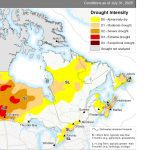More than ever, producers with excess straw should consider alternatives to burning.
The drought has caused a feed shortage and increased the danger of fires getting out of control.
“More and more producers are working straw into their winter feeding program as a means of lowering their feed costs,” says Kathy Martin, a beef development specialist with Saskatchewan Agriculture.
“Some producers, for example, will use up to one round straw bale of straw per animal per winter feeding period, with another bale used for bedding during the same period.”
Read Also

Alberta eases water access for riparian restoration
Alberta government removes requirement for temporary diversion licence to water plants up to 100 cubic metres per day for smaller riparian restoration projects
Feedlots also need straw. Some small- to medium-sized feedlots use about one bale per feeder per year for bedding and, this year, up to one-third a tonne per feeder per year as part of the rations.
Martin said grain farmers should consider contacting their nearest livestock producers about stubble grazing or baling their straw.
Some livestock producers will fence a grain farmer’s field if their cattle are allowed to stubble-graze after harvest. The advantages to the grain farmer are several:
- Stubble grazing reduces residue, yet leaves enough ground cover to collect snow and still warm quickly in the spring.
- Manure combined with the residue improves the soil.
- Cattle also graze headlands and sloughs.
While straw alone does not provide adequate nutrition, it is a low-cost complement to rations.
“Like any feed, straw provides some protein and energy, so it can be used as part of the nutritional balance. After calves are weaned, in fact, when the cow’s nutritive requirements are less, it often makes sense to use straw as part of the ration.”
The amount depends on the cow’s condition, which is the most important part of the equation.
The cost of poor conditioning shows up at calving and rebreeding.
















